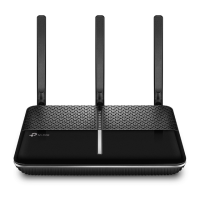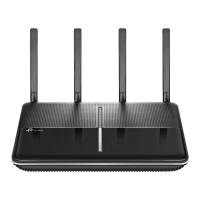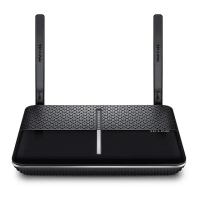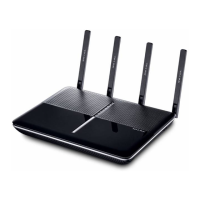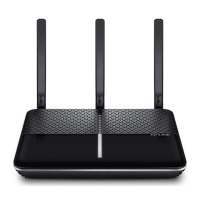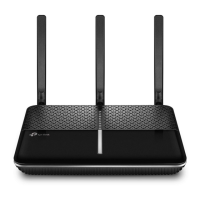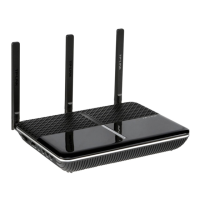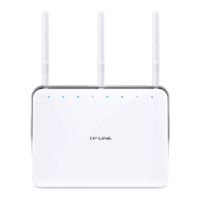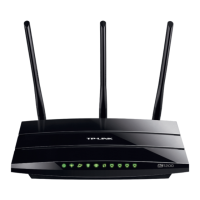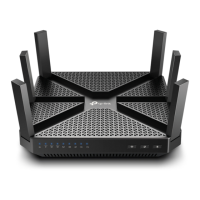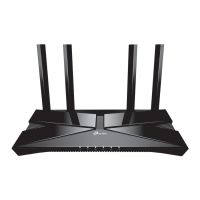Do you have a question about the TP-Link Archer VR2100 and is the answer not in the manual?
Overview of the modem router's capabilities and design.
Details the physical layout of the modem router's ports and buttons.
Guidance on optimal placement for Wi-Fi performance and network security.
Step-by-step instructions for connecting the modem router hardware.
Guide for using the automated setup wizard for internet connection.
Instructions for configuring the internet connection manually.
Guide for configuring IPv6 connectivity if supported by the ISP.
Options for using the modem router in different modes.
Steps to create a TP-Link ID for cloud services.
How to modify TP-Link ID account details like email and password.
Using the Tether app for remote management.
Instructions for creating a unified Wi-Fi network with OneMesh extenders.
How to view and manage devices within the OneMesh network.
Guide to setting up a separate Wi-Fi network for guests.
Configuring specific settings for the guest network.
How to access files on USB storage connected to the router.
Enabling media streaming from USB devices.
Configuring the router for 3G/4G USB modem use.
Setting up Quality of Service rules to manage network traffic.
Instructions for updating the QoS database for application recognition.
Configuring the firewall and Denial of Service protection.
Blocking or allowing specific network services.
Controlling access for specific devices using MAC or IP addresses.
Binding IP addresses to MAC addresses to prevent spoofing.
Configuring firewall rules for IPv6 networks.
Enabling Application Layer Gateway for NAT traversal.
Setting up virtual servers to share local resources online.
Configuring port triggering for dynamic port opening.
Using DMZ to expose devices to the internet without port restrictions.
Enabling UPnP for smoother online gaming and applications.
Setting up an OpenVPN server for secure remote access.
Configuring PPTP VPN for remote access.
Setting up an IPSec VPN for secure remote access.
Configuring local area network settings.
Configuring IPv6 settings for the LAN.
Customizing Wi-Fi settings like SSID, password, and security.
Configuring DDNS for remote access using a domain name.
Setting up static routes for specific network traffic paths.
Establishing IPv6 tunnels for IPv6 connectivity.
Configuring the router's system time for accurate logging and scheduling.
Managing the router's LED indicators, including night mode.
Procedures for updating the router's firmware.
Backing up and restoring router configurations.
Manually or automatically rebooting the modem router.
Modifying the login credentials for the router's web interface.
Managing the router from the local network.
Enabling and configuring remote management over the internet.
Viewing and saving system logs for troubleshooting.
Monitoring network traffic statistics for interfaces.
Configuring CWMP (TR-069) for remote device management.
Configuring SNMP for network management.
Restoring the router to its original factory default settings.
Steps to recover or reset forgotten login or wireless passwords.
Troubleshooting steps for accessing the router's web interface.
Diagnosing and resolving issues with internet connectivity.
Manually changing the MAC address for internet access.
Configuring computer network settings to obtain IP addresses automatically.
Troubleshooting wireless network detection and connection problems.
Overview of the modem router's capabilities and design.
Details the physical layout of the modem router's ports and buttons.
Guidance on optimal placement for Wi-Fi performance and network security.
Step-by-step instructions for connecting the modem router hardware.
Guide for using the automated setup wizard for internet connection.
Instructions for configuring the internet connection manually.
Guide for configuring IPv6 connectivity if supported by the ISP.
Options for using the modem router in different modes.
Steps to create a TP-Link ID for cloud services.
How to modify TP-Link ID account details like email and password.
Using the Tether app for remote management.
Instructions for creating a unified Wi-Fi network with OneMesh extenders.
How to view and manage devices within the OneMesh network.
Guide to setting up a separate Wi-Fi network for guests.
Configuring specific settings for the guest network.
How to access files on USB storage connected to the router.
Enabling media streaming from USB devices.
Configuring the router for 3G/4G USB modem use.
Setting up Quality of Service rules to manage network traffic.
Instructions for updating the QoS database for application recognition.
Configuring the firewall and Denial of Service protection.
Blocking or allowing specific network services.
Controlling access for specific devices using MAC or IP addresses.
Binding IP addresses to MAC addresses to prevent spoofing.
Configuring firewall rules for IPv6 networks.
Enabling Application Layer Gateway for NAT traversal.
Setting up virtual servers to share local resources online.
Configuring port triggering for dynamic port opening.
Using DMZ to expose devices to the internet without port restrictions.
Enabling UPnP for smoother online gaming and applications.
Setting up an OpenVPN server for secure remote access.
Configuring PPTP VPN for remote access.
Setting up an IPSec VPN for secure remote access.
Configuring local area network settings.
Configuring IPv6 settings for the LAN.
Customizing Wi-Fi settings like SSID, password, and security.
Configuring DDNS for remote access using a domain name.
Setting up static routes for specific network traffic paths.
Establishing IPv6 tunnels for IPv6 connectivity.
Configuring the router's system time for accurate logging and scheduling.
Managing the router's LED indicators, including night mode.
Procedures for updating the router's firmware.
Backing up and restoring router configurations.
Manually or automatically rebooting the modem router.
Modifying the login credentials for the router's web interface.
Managing the router from the local network.
Enabling and configuring remote management over the internet.
Viewing and saving system logs for troubleshooting.
Monitoring network traffic statistics for interfaces.
Configuring CWMP (TR-069) for remote device management.
Configuring SNMP for network management.
Restoring the router to its original factory default settings.
Steps to recover or reset forgotten login or wireless passwords.
Troubleshooting steps for accessing the router's web interface.
Diagnosing and resolving issues with internet connectivity.
Manually changing the MAC address for internet access.
Configuring computer network settings to obtain IP addresses automatically.
Troubleshooting wireless network detection and connection problems.
| Storage temperature (T-T) | -40 - 70 °C |
|---|---|
| Operating temperature (T-T) | 0 - 40 °C |
| Storage relative humidity (H-H) | 5 - 90 % |
| Operating relative humidity (H-H) | 10 - 90 % |
| Mac operating systems supported | macOS |
| Linux operating systems supported | Yes |
| Windows operating systems supported | Windows 10, Windows 2000, Windows 7, Windows 8, Windows 8.1, Windows 98SE, Windows Vista, Windows XP |
| Cables included | LAN (RJ-45), Phone (RJ-11) |
| Certification | CE, RCM, RoHS |
| Cabling technology | 10/100/1000Base-T(X) |
| Networking standards | IEEE 802.3, IEEE 802.3ab, IEEE 802.3u |
| VPN tunnels quantity | 10 |
| Ethernet LAN data rates | 10, 100, 1000 Mbit/s |
| Ethernet LAN interface type | Gigabit Ethernet |
| Number of guest networks (2.4 GHz) | 1 |
| Supported network protocols | IPv4, IPv6 |
| Output current | 1.5 A |
| Output voltage | 12 V |
| Power source type | DC |
| SIM card slot | No |
| WAN connection type | RJ-45 |
| Wi-Fi band | Dual-band (2.4 GHz / 5 GHz) |
| Wi-Fi standards | 802.11a, 802.11b, 802.11g, Wi-Fi 4 (802.11n), Wi-Fi 5 (802.11ac) |
| Top Wi-Fi standard | Wi-Fi 5 (802.11ac) |
| WLAN data transfer rate (max) | 1733 Mbit/s |
| WLAN data transfer rate (second band) | 300 Mbit/s |
| Security algorithms | 64-bit WEP, 128-bit WEP, WPA, WPA-PSK, WPA2, WPA2-PSK |
| Antennas quantity | 4 |
| 3G | - |
| Product type | Tabletop router |
| Product color | Black |
| LED indicators | LAN, Power, Status, WLAN |
| Ethernet LAN (RJ-45) ports | 3 |
| Package depth | 240 mm |
| Package width | 318 mm |
| Package height | 71 mm |
| Package weight | 1170 g |
| Depth | 164 mm |
|---|---|
| Width | 216 mm |
| Height | 36.8 mm |
